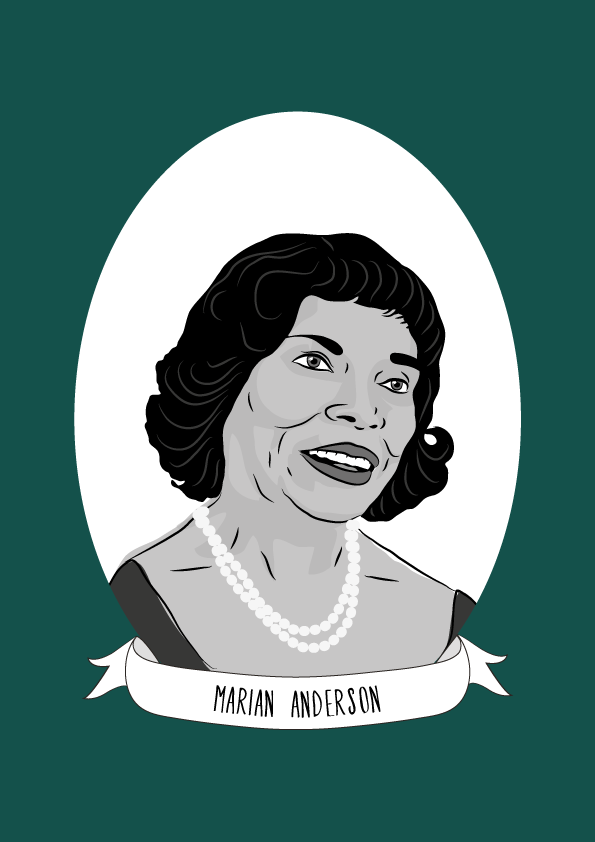Marian Anderson was an American singer and one of the finest contraltos of her time. She became the first African American to perform with the New York Metropolitan Opera in 1955 and an important figure in the struggle for black artists to overcome racial prejudice in the United States.
Anderson was born in South Philadelphia in 1897. She started singing at the Union Baptist Church which was the heart of their community. Anderson’s Aunt Mary was active in the church and convinced her to join the junior choir when she was six. Anderson performed solos and duets, often with her Aunt who influenced her choice in pursing a singer career. Anderson began singing at local functions at the age she joined the church choir and also performed at local churches, the YMCA, benefit concerts, and other community music events. At 14, Anderson was moved to the adult choir due to her musical talent. She was able to sing any part of a hymn on demand and stunned the other choir members with the strength and beauty of her voice.
The pastor of the Union Baptist Church along with the directors of the People’s Chorus and other leaders in the black community started the “Marian Anderson’s Future Fund,” which enabled Anderson to take lessons with the city’s leading voice instructors and support her performances. It also allowed her to attend South Philadelphia High School, from which she graduated in 1921. Anderson experienced racial discrimination when applying to the Philadelphia Music Academy (now University of the Arts) where she was turned away by an admissions woman stating “We don’t take coloured”. Undeterred, Anderson continued to be supported by Philadelphia black community who allowed her to be privately taught by Giuseppe Boghetti and Agnes Reifsnyder. Anderson’s rendition of ‘Deep River’ had apparently brought Boghetti to tears.
In 1925 Anderson won first prize in a singing competition sponsored by the New York Philharmonic. She performed in concert at the Lewisohn Stadium in New York with the orchestra on August 26, 1925, gaining her immediate success with both audience and music critics. She performed a number of concerts in the United States for the next few years but racial prejudice prevented her career from progressing. In 1928 she performed at Carnegie Hall for the first time and in 1930, thanks to a Julius Rosenwald scholarship she made her European debut in a concert at Wigmore Hall in London. She spent the early 1930’s touring successfully in Europe where she did not encounter the racial prejudice she was subjected to in the U.S. Anderson performed for King Gustav in Stockholm and King Christian in Copenhagen and the people of Europe flocked to see her.
In 1935 Anderson returned to the U.S. and made her first recital appearance at Carnegie Hall in New York. Anderson’s performance won her a level of popularity that lead to her becoming the first African American to be invited to perform at the White House when she sang for Franklin and Eleanor Roosevelt who were entertaining the King and Queen of Great Britain in 1939. Some of American retained their racial prejudice though, that same year Anderson’s managed tried to book her to perform at Washington, D.C.’s Constitution Hall but the Daughters of the American Revolution (D.A.R) informed her that there were no dates available but this was a lie. The D.A.R had a policy that only white performers could play at the hall. An uproar followed, lead by Eleanor Roosevelt who publicly resigned from the D.A.R. in protest. Roosevelt invited her to perform at the Lincoln Memorial on Easter Sunday. Anderson performed to a crowd of over 75,000 people, her voice was broadcast live for millions of radio listeners. In 1943 the D.A.R. invited Anderson to sing at the hall, both black and white concert-goers attended.
As well as singing, Anderson also worked for several years as a delegate to the United Nations Human Rights Committee and as a “goodwill ambassadress” for the United States Department of State, giving concerts all over the world. She was an active participant in the civil rights movement in the 1960’s, singing at the March on Washington for Jobs and Freedom in 1963. Anderson continued to perform and had a successful career for years, she performed the national anthem at President John F. Kennedy’s inauguration. Two years later the President awarded her with the Presidential Medal of Freedom. In 1955 she became the first African American to perform at the Metropolitan Opera. In 1965 she gave her final performance at Carnegie Hall in New York. Anderson was honoured with a Grammy Award for Lifetime Achievement in 1991. She had gone from being a singer who had once been barred from performing in the nation’s capital and who had been forced to use the back entrance at posh hotels to an American musical icon.
